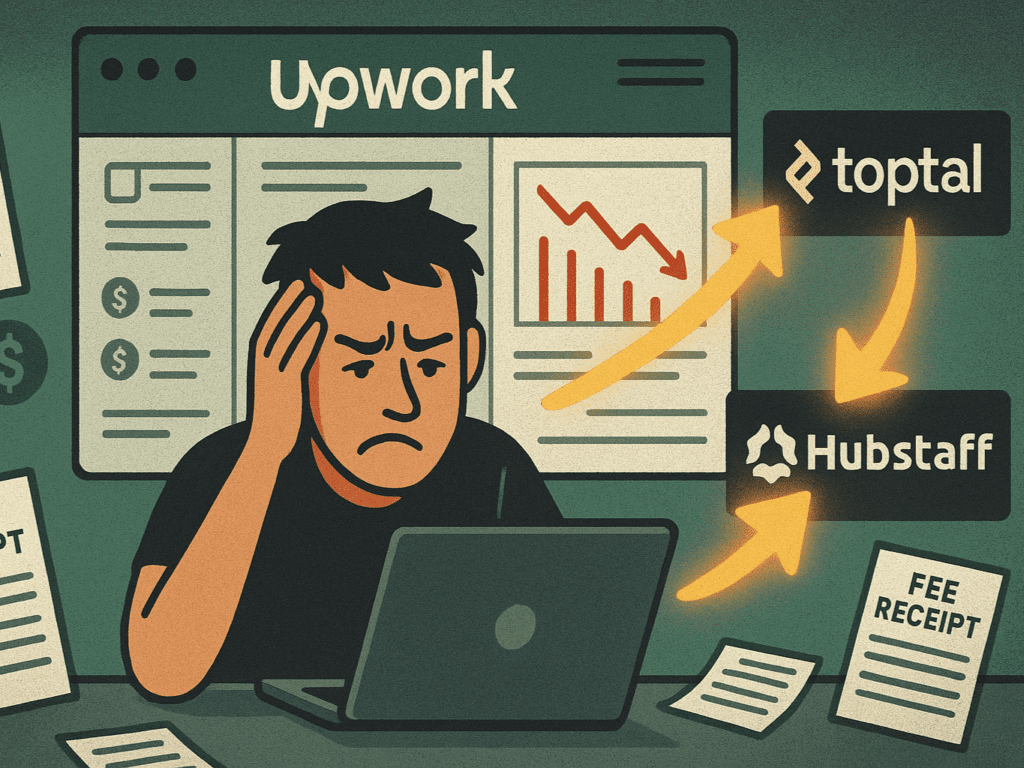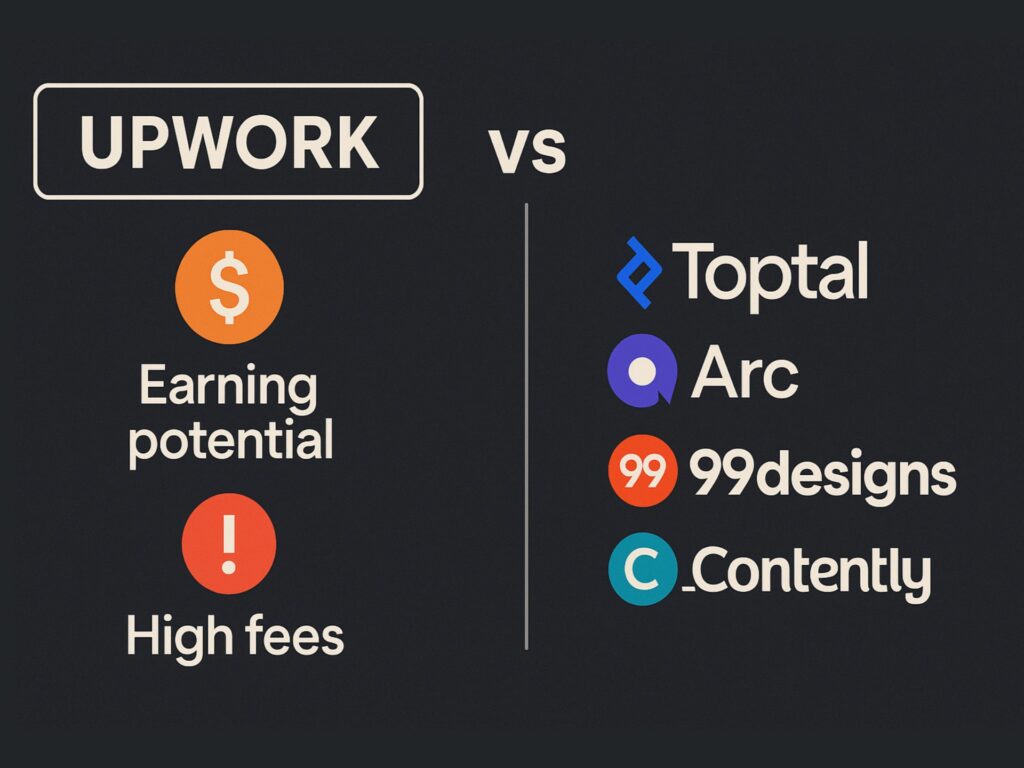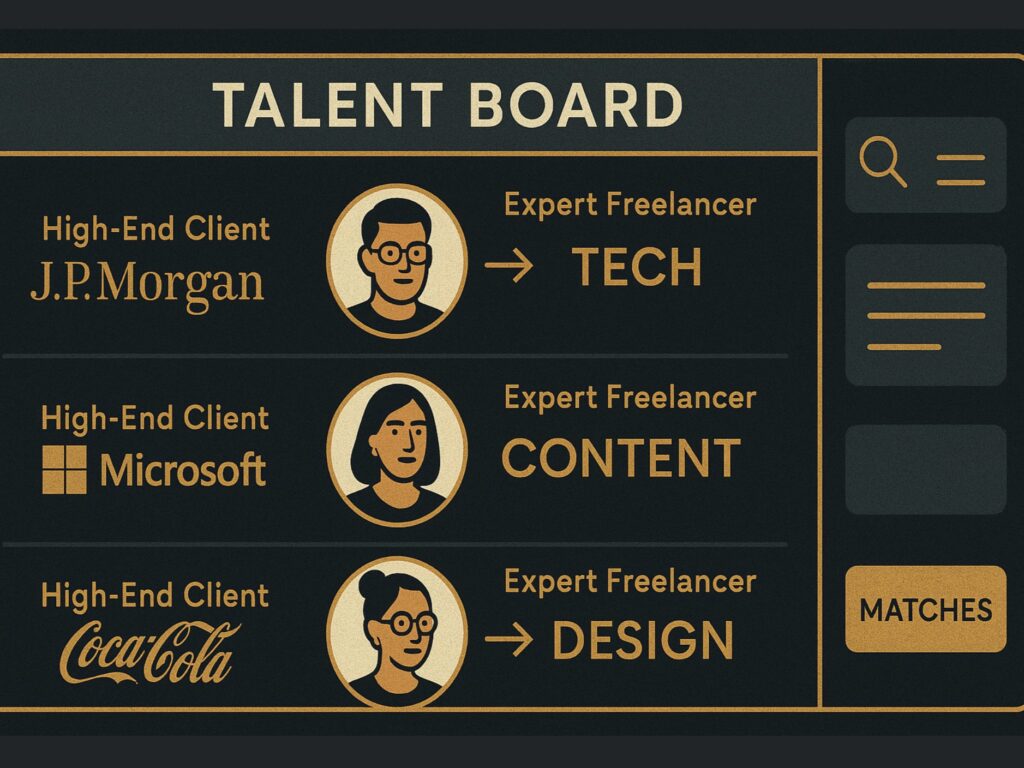Freelancers now look at Upwork alternatives more often due to the platform’s 10% fee on projects. The challenge to stand out among 18 million active freelancers makes the switch more appealing. Upwork controlling 61% of the freelance market means businesses also pay extra fees of 5-10% plus contract startup costs, which pushes both clients and freelancers to search for better options.
Our research shows several platforms that offer better deals for freelancers. You can keep more of your earnings through commission-free platforms like Hubstaff Talent. Elite marketplaces like Toptal connect businesses with the top 3% of talent. Many options help freelancers maximize their income. This guide will help you find platforms that line up with your earning goals in 2025, whether you’re questioning Upwork’s value or ready to make a change.
Why Freelancers Are Leaving Upwork in 2025

The freelance world is changing fast, and more professionals in 2025 are exploring Upwork alternatives. While Upwork remains one of the largest freelance platforms, growing concerns around high fees, algorithm changes, and client quality are pushing many to seek better options. Let’s dive into why so many freelancers are searching for a more innovative way to work.
1. High fees are eating into your profits
Working through Upwork has become too expensive for freelancers. Starting May 1, 2025, Upwork plans to move from its 10% service fee to a variable fee structure that changes based on client demand for specific work types. This new pricing makes it hard for freelancers to know exactly how much they’ll earn.
The old system already took a big chunk of earnings:
- 20% for the first $500 billed with each client
- 10% for billings between $500.01 and $10,000
- 5% for billings over $10,000
These fees come straight out of your earnings, even from client bonuses. On top of that, clients pay a 5% fee on every payment plus a one-time charge up to $4.95 for contracts started after April 2023. Projects end up costing clients more while you earn less. It’s changes like these that raise questions among freelancers and businesses alike: Is Upwork worth it anymore?
2. Increasing competition is driving rates down.
Quality projects are more challenging to find as more freelancers join the platform. Almost half of businesses (49%) now use freelancers to fill skill gaps, and 48% of CEOs want to hire more freelancers next year. More demand means more competition.
Many freelancers feel they must lower their rates to stay competitive. One market watcher said, “AI has been killing Upwork slowly for the past few years.” It refers to how AI tools let more people offer services they couldn’t before.
The platform creates a downward price spiral because:
- New freelancers often bid low to get their first clients
- Experienced freelancers must prove why they charge more
- Global competition means working against professionals from cheaper locations
3. Limited payment protection
Upwork talks about security, but its payment protection has big gaps. Hourly Payment Protection only works for time tracked through their Desktop App, which meets certain rules. You won’t get protection for:
- Manually added time
- Idle or empty time segments
- Time showing non-work-related activity
- Time with missing or weak memos
Fixed-price contracts require clients to pay upfront, but you only get paid after milestone approval or automatically after 14 days. All the same, if disputes happen, Upwork might freeze your contract and set your weekly limit to zero until things get sorted.
Clients can also reverse payments through their bank, even though it’s against Upwork’s rules. Banks make the final call in these cases, not Upwork.
4. Difficulty standing out among millions
Getting noticed might be the most formidable challenge. The platform has so many users that standing out is nowhere near easy. One freelancer put it well: “Generalists struggle, but specialists thrive.” Without specific skills that set you apart, your proposals might disappear in the crowd.
Building trust is tricky; you need good reviews to get work, but you can’t get reviews without work first. Many people start with smaller, less profitable jobs just to build their reputation.
The platform’s search system makes things more complicated. New freelancers don’t show up well without an optimized profile and client reviews. About 74% of executives say degrees don’t matter much when hiring freelancers – they want proven expertise. Your portfolio and real-world experience are more vital than ever.
These problems make many freelancers question if they should stay with Upwork. Their established history keeps them there. But as fees go up and competition gets fiercer, more people want to break down other platforms that offer better deals.
Best Upwork Alternatives 2025 With Better Pay Structures

The freelance landscape in 2025 shows several promising platforms that can boost your income beyond Upwork. These best upwork alternatives come with better payment terms and unique benefits that help freelancers earn more.
1. Specialized tech platforms (Toptal, Arc, CloudDevs)
Tech professionals can earn significantly more on platforms that value expertise over volume. The quality-first approach of these platforms creates excellent earning potential.
(i) Toptal
leads the premium freelancing space:
- Only the top 3% of freelance talent cuts through tough screening.
- Freelancers keep 100% of their earnings with zero platform fees.
- You can earn $60-$250+ hourly based on your expertise.
- Projects span software development, design, finance, and project management.
(ii) Arc
takes selectivity even further:
- A mere 2.3% of applicants get accepted.
- Straightforward pricing lets freelancers charge $15-$110+ per hour.
- Your stated rate stays intact without extra fees.
- Clients get a two-week trial period.
(iii) CloudDevs
makes waves as a rising star:
- A talent pool of 8,000+ senior developers and designers undergoes pre-screening.
- Clients and talent get matched within 24 hours.
- US clients work with Latin American talent in matching time zones.
- A transparent pricing structure eliminates surprises.
2. Design-focused marketplaces (99designs, Dribbble)
Creative professionals often earn better on design-specific platforms compared to general freelance sites.
(i) 99designs
gives designers two ways to work:
- Designers compete in project contests.
- Experienced designers can work with clients directly.
- Fees work out to 5% from clients plus 5-15% from designers based on their level.
- Contest prices range from $199 for basic work to $2,499 for premium designs.
(ii) Dribbble
combines a portfolio showcase with client connections:
- The platform blends social networking, design education, and job-matching.
- Premium hiring tools cost $10 daily, billed monthly.
- Clients can search for designers by past work, location, skills, and rates.
- The platform excels at matching specific design styles with the right clients.
3. Content creation platforms (Contently, Skyword)
Content creators find premium rates on specialized content production platforms.
Contently and Skyword connect writers with top-tier clients:
- Both platforms maintain 4.4-star ratings.
- Contently scores 8.9 in content management and freelancer screening.
- Skyword leads with payment automation (9.3) and SEO optimization (8.8).
- Skyword puts audiences first with real-time data and automation.
- Contently helps enterprise brands create powerful content.
4. General freelance marketplaces with lower fees
Some platforms offer Upwork-like features but with better terms.
FlexJobs takes a unique approach:
- Carefully vetted job listings keep scams away.
- You pay a subscription instead of project commissions.
- The platform adds value with skill tests and webinars.
- A 30-day money-back guarantee protects your investment.
Pangea.app rewards loyalty with better rates:
- Fees start at 20% but decrease as you earn more.
- Your fees drop permanently to 5% after earning $4,000.
- The platform leads to opportunities to reduce fees through consistent work.
The best Upwork alternative depends on more than just fees. Look at project quality and client caliber, too. Specialized platforms often pay better than general marketplaces if you have specific skills. Pre-vetted client platforms might charge membership fees or have strict requirements, but they usually offer stability and higher rates that make it worthwhile.
Platforms With No Fees: Are Free Upwork Alternatives Worth It?
The promise of completely free Upwork alternatives sounds almost too good to be true for freelancers seeking better earnings. Several platforms go beyond offering improved commission structures and claim to take no fees from freelancers. A question remains, though: do these zero-commission platforms deliver real value, or do they come with hidden compromises?
1. Hubstaff Talent: Zero commission structure
Hubstaff Talent stands out as a genuine free alternative to Upwork that takes a refreshingly transparent approach to freelance marketplace economics:
- Zero commissions guaranteed: Hubstaff Talent charges no fees or commissions to businesses or freelancers, unlike Upwork’s sliding 5-20% fee structure.
- No hidden charges: Their slogan, “No fees. No markups. No middlemen,” matches their business model, which has remained unchanged since they launched in September 2016.
- Growing talent pool: The platform now hosts over 50,000 freelancer profiles who specialize in design, development, writing, and marketing.
Of course, this zero-commission structure raises questions about Hubstaff Talent’s sustainability. The answer lies in their integrated ecosystem – Hubstaff Talent acts as a talent acquisition channel for their paid time-tracking and project management tools, which businesses can use after finding freelancers.
Hubstaff Talent’s users have complete freedom to:
- Communicate through their preferred channels
- Use their chosen payment methods
- Work with their existing project management tools
This flexibility creates a stark contrast to Upwork’s requirement that all communications and payments stay within their platform.
2. Direct client platforms and their benefits
The landscape extends beyond Hubstaff Talent, with several platforms connecting freelancers to clients without taking a cut:
We Work Remotely asks businesses to pay $299 to post jobs while keeping it free for freelancers. The high posting fee screens out low-quality clients and results in better opportunities.
Platforms like Flexiple take their fees only from hiring companies, not freelancers. This approach lets freelancers keep 100% of their earnings while they still benefit from matching services and client vetting.
These direct-connection platforms offer key advantages:
- Full earnings retention: Your pocket stays fuller without percentage-based fees.
- Direct relationship building: You’re free to build long-term client relationships without platform dependencies.
- Payment flexibility: You can use your preferred payment methods without processing fees.
3. Hidden costs to watch out for
“Free” rarely means there’s no cost at all. Zero-commission Upwork alternatives might have these hidden expenses:
Many free platforms lack reliable payment protection systems found on fee-charging sites. Freelancers face greater non-payment risks without escrow services or dispute resolution processes.
Freelancers must realize they’re running their businesses, which brings responsibilities that platforms usually handle for a fee. One industry source explains that “Freelancing platforms don’t take all these things out of the equation, but they make them exponentially easier to manage.”
These often-overlooked aspects of “free” platforms deserve attention:
- Time costs: You’ll spend more time sorting through opportunities on free platforms that attract budget-conscious clients.
- Self-management burden: You handle contracts, invoicing, and tax documentation yourself.
- Marketing requirements: You need more self-promotion without algorithmic matching.
Zero-commission platforms like Hubstaff Talent offer clear financial benefits but require more self-sufficiency. Experienced professionals with established business practices often find these trade-offs worthwhile. Newcomers might justify paying platform fees for additional support despite lower take-home pay.
Niche Platforms That Pay Premium Rates

Quality-focused marketplaces have emerged as alternatives to general freelance platforms. These exclusive platforms link premium clients with expert talent, creating an environment where skill excellence matters more than numbers.
1. Industry-specific marketplaces
Targeted platforms deliver better opportunities than broader sites like Upwork. Here’s how these marketplaces serve different specialties:
(i) For developers and tech professionals
- Toptal: Accepts only the top 3% of talent after strict screening.
- Codeable: WordPress-specific platform that uses algorithms to ensure fair pay.
- Gun.io: Exclusive to “exceptional developers” with detailed vetting.
(ii) For designers and creatives
- DesignHill: A Creative marketplace that specializes in logo creation, stationery, and packaging.
- 99designs: Features contest models and direct hiring options.
- Dribbble: Let designers showcase portfolios and connect with millions of creatives.
(iii) For writers and content creators
- Writer Access: Perfect for starting a freelance copywriting career.
- Skyword: Platform dedicated to content strategists, editorial managers, and technical writers.
- Constant Content: This lets you sell pre-written articles or take specific requests.
These specialized platforms stand out by prioritizing quality over quantity. While general marketplaces focus on large talent pools, niche sites emphasize expertise and specialization that create better matches between clients and freelancers.
2. Why specialization leads to higher pay
Specialization brings clear financial rewards:
- Expert freelancers earn more, with rates from $50-$150 per hour for web designers and $30-$100+ per hour for PeoplePerHour specialists.
- Toptal freelancers can earn between $100-$250 per hour based on expertise.
- Arc’s selective 2.3% acceptance rate creates a premium market that drives higher rates.
Expert freelancers become “market monopolies” and can charge premium rates for their exceptional work. Clients on these platforms seek specific expertise and value quality over cost.
Premium rates come from solving complex, unique challenges rather than basic tasks. Clients hire you for your specific skills, which makes you a consultant rather than just a service provider.
3. How to qualify for elite platforms
Getting into these exclusive platforms needs careful preparation:
(i) Portfolio development
- Show specialized skills instead of general abilities
- Include work that tackles specific industry problems
- Feature projects from well-known brands when possible
(ii) Skill enhancement
- Keep your skills current to stay competitive
- Target emerging fields like AI consulting and blockchain, where experts are scarce
- Build expertise in solving unique and complex problems
(iii) Application strategies
- Get ready for strict multi-stage screening
- Toptal includes English tests and project assessments
- Platforms like Gigged AI look for specific skills rather than general experience
Toptal’s five-step selection process accepts only the best freelancers, and rejected candidates must wait months to try again. This strict screening creates a marketplace where rates match actual expertise, making the effort worth it for those who make it through.
These niche platforms represent the top tier of Upwork alternatives in 2025. They reward specialized skills with better earning potential for those ready to develop expertise and pass strict screening processes.
Payment Models That Maximize Your Earnings
Your income as a freelancer depends more on how you structure your payments than on which platform you use. The right payment model helps you earn more money on Upwork or any other platform.
1. Hourly vs fixed-price: Which pays better?
Freelancers always debate this question: Should you bill by the hour or charge per project? Your work style and project type will determine which model suits you best.
With hourly contracts:
- You’ll always get paid for time worked, with protection against non-payment
- Upwork’s hourly protection covers verified work through their Desktop App
- Projects without a clear scope work better with hourly pricing since you get paid for all your time
- Clients can set weekly limits on billable hours to control budgets
Fixed-price contracts have their advantages:
- Clients know their budget upfront, and you know exactly what you’ll earn
- Payment usually comes in milestones, with funds held in escrow
- You make more money by working efficiently and finishing quickly
- Payment happens automatically when you complete the work
Fixed-price contracts work best for short-term projects with clear deliverables. Hourly billing makes more sense for long-term work or projects that might change scope.
2. Retainer agreements and their advantages
Retainer agreements give you stability that’s hard to find on Upwork. Clients pay you a fixed amount each month to access your services whenever needed.
Key benefits include:
- Consistent monthly income: helps you plan your finances better
- Reduced marketing time: steady clients mean less time hunting for work
- Improved client relationships: You learn what your clients need over time
- Prioritized scheduling: Retainer clients get your attention first
Retainers work best for ongoing services like social media management, newsletter design, or website maintenance. Most clients pay upfront, so you won’t have to chase payments.
3. Profit-sharing and equity options
Mutually beneficial alliances beyond regular freelancing can lead to bigger rewards if you’re ready to share the risk.
Profit-sharing plans give contractors a cut of company profits, which aligns your success with the company’s growth. Companies can put in up to $66,000 or 100% of their pay annually (as of 2023).
You can get ownership stakes through:
- Stock options (ISOs for employees, NSOs for contractors)
- Phantom equity pays when the company sells or hits milestones
- Profit Interest Units (PIUs) for LLCs
Virtual shares have become popular with platforms that work with freelancers. They create an ownership mindset without traditional employment.
Before you jump into equity or profit-sharing, take time to understand the deal. These options work best when you believe the company will grow and you’re comfortable with uncertain pay for potentially bigger rewards.
Many freelancers now use automated billing software to schedule regular payments. It brings more stability to their income.
How to Transition From Upwork to Better-Paying Sites
Moving away from Upwork needs careful planning and brilliant timing. Better-paying alternatives in 2025 won’t appear magically. This transition takes time, and you should start while you are still working on the platform.
1. Building your portfolio for premium platforms
Elite platforms demand compelling work samples that highlight your expertise. Platforms like Toptal and Arc carefully screen applicants and accept all but one of these candidates.
Your portfolio should be ready for these selective platforms:
- Build a freelance website that shows your best work and core skills
- Write detailed descriptions of problems you solved
- Show your best projects instead of everything in your portfolio
- Make your portfolio visible on search engines
Your website acts as a digital storefront. It helps you establish credibility and lets potential clients learn about your services easily.
2. Transferring client relationships off-platform
Direct relationships with existing Upwork clients need careful handling. You must check Upwork’s terms of service first; most platforms set specific waiting periods before direct client work.
Show clients you’ve worked with for 4+ years the financial benefits. One freelancer saved $4,000 each year by moving off-platform, which made a strong case for the change. The benefits you can highlight include:
- Lower costs since there are no platform fees
- Better communication options
- Easier payment methods
3. Managing your reputation across multiple sites
Your reputation won’t automatically transfer between platforms. You need to build trust on each alternative platform. Deliver work early and offer occasional free services to exceed client expectations.
Keep your LinkedIn profile and industry community presence active during this transition. Build connections with your niche’s influencers and ask happy clients for recommendations. Each successful project adds to your reputation, which reduces your reliance on any one platform.
Final Thoughts: Is Upwork worth it?

Freelancers can earn much higher rates and find better opportunities in 2025 by expanding beyond Upwork. Some of the best Upwork alternatives, like premium platforms Toptal and Arc, pay top rates for skilled professionals. Meanwhile, free Upwork alternatives like Hubstaff Talent let freelancers retain more of their earnings with no commission fees.
Your success on these alternative platforms relies on these essential elements:
- A compelling portfolio that shows your specialized skills
- Wise choices about payment structures that suit your workflow
- Your reputation’s careful management on each platform
- A smooth transition that protects your client relationships
Most experienced freelancers get the best results when they use various platforms instead of sticking to just one marketplace. This strategy lets you use each platform’s advantages while reducing its limitations.
Note that you don’t need to abandon your 5-year-old Upwork profile right away. Look into other options while you keep your current income flowing, and make smart moves when new opportunities come up. The switch takes work, but higher earnings and better working conditions make it worth the effort for freelancers aiming to grow in 2025.





